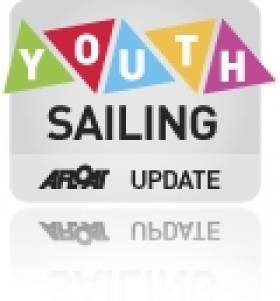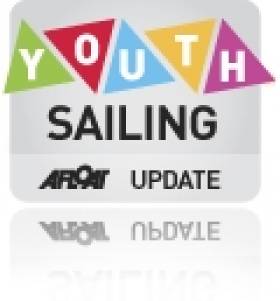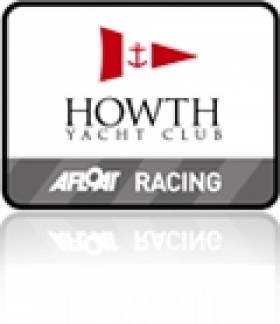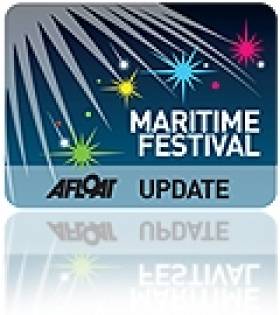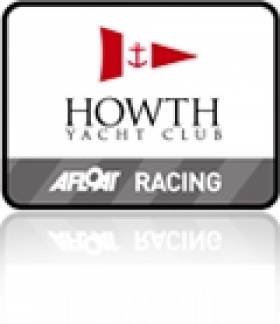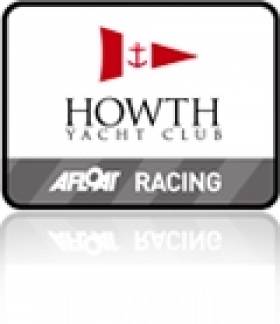Displaying items by tag: Howth Yacht Club
Strengthen Fingal's Freedom for the Good of Irish Sailing
#fingal – The Government's recent move to create a framework for the direct election of a new all-powerful Mayor for Dublin was expected to be a shoo-in. The new Super-Mayor's authority would incorporate the current four local councils of Dun Laoghaire-Rathdown, South Dublin, Dublin City, and Fingal, each one of which had to vote in favour. But Fingal's councillors voted firmly against it, despite emphatic support of the proposal by the councillors in the other three areas. As a Fingallion by adoption, W M Nixon strongly supports this independent move by a largely rural and coastal region which has a longer shoreline than all the other Dublin areas put together, and is clearly not a naturally integral part of the city.
Fingal is the Ukraine of Leinster, and the glowering monster of Dublin is the Russia within Ireland, intent on the conquest of its smaller freedom-seeking neighbour. Vigorous, all-powerful, intensely urban, and distinctly impressed with itself, Dublin is certain that the further its bounds are spread, the better it will be for all its citizens. And the more citizens it can claim, then the better for Dublin.
But Fingal is different. For sure, it can seem a bit sleepy and rural by comparison with central Dublin, but that's the way we like it. It's a place of odd little ports and much fishing, a region of offshore islands, rocky coasts and many beaches on one side, and the profound heart of the fertile country on the other. A place where – as you move north within it - you might make a living in many ways at once, taking in growing vegetables, raising animals, running a dairy herd, and keeping a lobster boat down at the local quay, while perhaps having a horse or two as well. And if you feel like more shore sport, the golfing options are truly world class.
As for the sailing and all other forms of recreational boating, Fingal is not just a place of remarkable variety – it's a universe. With five islands – six if you count Rockabill – its 88 kilometre coastline is one for sport, relaxation and exploration. Sea angling is well up the agenda, and it's a kayakers' paradise, while Irish speed records in sailboarding and kite-surfing have been established in the natural sand-girt canal which forms for much of the tidal cycle in the outer Baldoyle estuary immediately west of Howth.
Apart from fishing boats – and inshore they're usually only the smaller ones – it has no commercial traffic. And though there are tidal streams, in southern Fingal's main racing area between Ireland's Eye and Lambay, they're not excessively strong, and run in a reasonably clear-defined way, while the flukey winds which so often bedevil Dublin Bay away to the south are much less of a problem in sailing off Fingal, where the winds blow free.
The range of boat and sailing clubs of Fingal matches the variety of its coast. The most southerly is Sutton Dinghy Club, rare among Ireland's yacht clubs in being south-facing. It may be focused on sailing in Dublin Bay, but scratch any SDC sailor, and you'll find a Fingallion. Round the corner of the Baily – not a headland to be trifled with - Howth has two clubs, the yacht club with its own marina, and Cumann na Bhad Binn Eadair (the Howth Sailing & Boat Club) in the northeast corner of the harbour, while Howth Sea Angling Club with its large premises on the West Pier is one of the tops in the country.

The sunny south. Sutton Dinghy Club is Fingal's most southerly sailing club, and is also rare in Ireland through being south facing.
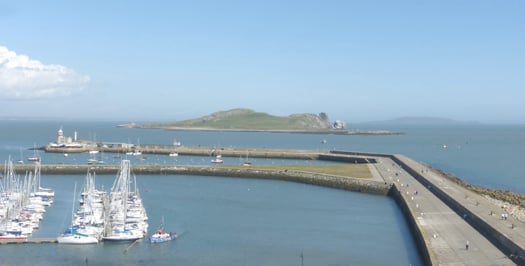
Islands of Fingal seen across the eastern part of Howth marina, with Ireland's Eye in the foreground, and Lambay beyond. Photo: W M Nixon
As for the waters they share, their most immediate neighbour is the steep island of Ireland's Eye with its pleasant southwest-facing beach, the island itself a remarkable wild nesting site, particularly when you remember that it's close beside an intensely urban setting. When a discerning visitor described Ireland's Eye as "an astonishing and perfect miniature St Kilda", he wasn't exaggerating.
Across in Malahide, where we find Fingal's other marina, Malahide YC - which recently celebrated its Golden Jubilee and currently has Graham Smith as its first second-generation Commodore – is in the curious position of having two clubhouses. One is a charming and hospitable place among trees within easy stroll of the marina, while the other is west of the long railway embankment which retains the extensive inner waters of Broadmeadow. This makes the waters into a marvellous recreational amenity and boating and sailing nursery, so not surprisingly it is home to active sailing schools. And it is also the base of Malahide YC "west", a dinghy sailing club on the Broadmeadow shore at Yellow Walls, while further west of it again is yet another club, the more recently formed Swords Sailing & Boating Club.

The map of modern Fingal shows how the southwest corner of the present region seems remote from the largely coastal and rural nature of much of the rest of the county. And it also confirms the surprise (to many) that the Phoenix Park is in Fingal.
North from Malahide, and you're into "Fingal profonde", its deeply rural nature occasionally emphasised by the sea nearby. The long Rogerstown Estuary, the next inlet after Malahide, sometimes found itself providing the northern boundary of The Pale, and as recently as the early 1800s the river at Rogerstown and the tiny port of Rush were a veritable nest of smugglers, privateers and occasionally pirates, with buccaneering captains of myth and legend such as Luke Ryan and James Mathews proving to have been real people who were pillars of society when back home in their secretive little communities after their lengthy business forays to God know where.

Muddy situation. Low water in the Rogerstown Estuary. The hill in the distance on the left is new – for years, it was the largest dump in Ireland, the Balleally Landfill. But now it is well on its way to rehabilitation as an enhancement of the landscape. Photo: W M Nixon
The Rogerstown Estuary went through an unpleasant period when its inner waters were dominated by the nearby presence of the biggest waste dump in Dublin, Balleally Landfill. It rose and rose, but now it's closed, and is in process of being revived to some sort of natural state. The result is that the vista westward from Rogerstown is much improved by a pleasant and completely new hill which so enhances the view at sunset that shrewd locals have built themselves a row of fine new houses facing west, along the quirkily named Spout Lane which runs inland from the estuary.
Whatever about the legality-pushing privateer skippers who used Rogerstown Estuary as their base in days of yore, these days it's home to the quay and storehouse which serves the ferry to Lambay, which is Fingal's only inhabited island when there are no bird wardens resident on Rockabill, and it's also the setting for another south-facing club, Rush SC. It is spiritual home these days to the historic 17ft Mermaid Class (they still occasionally build new ones in an old mill nearby), but despite the very strong tidal streams where the estuary narrows as it meets the sea, RSC also has a large cruiser fleet whose moorings are so tide-rode that unless there's a boat on the buoy, it tends to disappear under water in the final urge of the flood. This can make things distinctly interesting for strangers arriving in and hoping to borrow a mooring while avoiding getting fouled in those moorings already submerged. Not surprisingly, with their boat sizes becoming larger like everywhere else, Rush SC find that their bigger cruisers use Malahide Marina.
To seaward of Rogerstown, with the little port of Rush just round the corner, the view is dominated by Lambay. A fine big island with is own little "miniature Dun Laoghaire" to provide a harbour on its west side, it has a notable Lutyens house set among the trees. But for many years now Lambay has been a major Nature Reserve, so landing is banned, though anchorage is available in its three or four bays provided you don't interfere with the wildlife along the shore. This makes it off bounds to kayakers who might hope for a leg stretch on land, though it's still well worth paddling round close inshore.
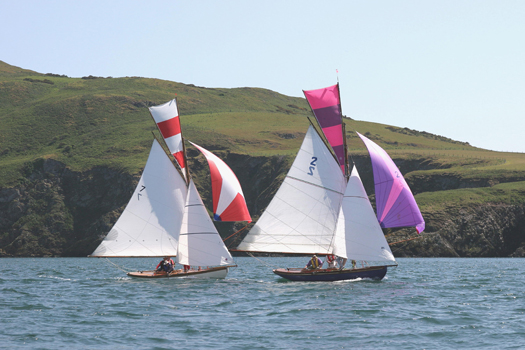
Racing round Lambay. Close competition between the Howth 17s Aura (left) and Pauline, which have been racing annually round Lambay since 1904. Photo: John Deane
Along the Fingal mainland coast, the next inlet after Rush is Loughshinny, a lovely natural harbour with a quay to further improve the bay's shelter. There's a very active little fishing fleet, while the shoreside architecture is, how shall we say, decidedly eclectic and individualistic? Go there and you'll see what I mean.
Six miles offshore, Rockabill marks the northeast limits of Fingal. It's a fine big double-rock, with a substantial lighthouse and characterful keepers' houses attached. But as it's now automated, the only time Rockabill is inhabited is for the four summer months when a bird warden or two take up residence to monitor the rocky island's most distinguished summer residents, Europe's largest breeding colony of roseate terns.
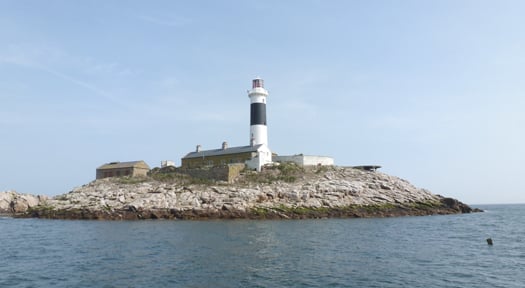
Rockabill, where the shy roseate terns feel at home. Photo: W M Nixon
In Fingal we tend to take these pretty but noisy summer visitors for granted, but the word is that south of Dublin Bay the tern buffs are so incensed by Rockabill having a clear run that they're tried to start a rival colony of roseate terns on the Muglins, and built a row of tern houses (one good tern deserves another) to facilitate their residence. The potential nest sites may not have survived the past severe winter. But in any case, one wonders if they had planning permission from Dun Laoghaire/Rathdown council for this development? Persons suggesting that such a development would almost certainly be terned down will not be given any attention whatsoever.
Skerries and Balbriggan are the two main sea towns of north Fingal, and they're as different as can be, the difference being emphasised by historic rivalry. It's said that back in the government harbour-building days of the late 19th Century a grant was made available to assist local landowners to make significant improvements to one of the harbours, and this meant war.

Balbriggan may very definitely dry out, but it provides a secure home port for both trawlers and other boats prepared to settle on the mud and sand. Photo: W M Nixon
So eventually the grant was split with half going to improve Balbriggan, and the other half to Skerries, with neither being a total success. If you seek total shelter in either today, you have to be prepared to dry out, while the anchorage off Skerries is also subject to a large tidal whorl which means that when the ebb is running in a strong onshore wind, the moorings are doubly rough and diabolically uncomfortable. And every so often after an exceptional nor'easter, we have another litany of boats driven ashore and Skerries yacht insurance going even further through the roof.
It's a situation which needs proper attention from an administration which is genuinely interested in the port. And the proper development of the harbour at Skerries, while retaining the little old place's special character, is surely something which could be much better done by Fingal Council rather than some remote Mayor of Dublin for whom Skerries will be the outermost periphery, a place seldom visited, if at all.
We've seen it all before. Time was when Fingal was simply the North County, little noticed in the centres of power which were basically Dublin City and Dublin County, their head offices in the heart of the city. But then in 2001 the new four-council setup was created, and the old name of Fingal – never forgotten by those who cherished the area – was revived. A very fine new user-friendly County Hall – it has even been praised by Frank McDonald of The Irish Times – was built in the re-born county town of Swords. Out on the new boundaries meanwhile, the signs went up saying "Welcome to Fingal County". But we old Fingallion fogeys pointed out that as Fingal means "Territory of the Fair Strangers" (i.e the Norsemen rather than the Danes), it was superfluous to be describing it as "the county of the territory", so these days it's just Fingal, and we're happy with that.
Here in Howth, we sort of slipped into acceptance of the new setup. Once upon a time, from 1917 to 1943, Howth had its own Urban District Council. It says much for the place's remoteness from the world that the HUDC was established in the midst of one global war, and quietly wound up in the midst of another. In 1943, Commissioners had to be imposed on the tiny fiefdom to offset the fact that some local interests thought the HUDC existed entirely for their own personal benefit. So at various times since, Howth was run either by Dublin County Council, or even by Dublin City Corporation. We were assured that this latter setup was all to our benefit, as the powers-that-be in City Hall had a soft spot for Howth, sure wasn't it the place where the mammy went every Thursday evening to buy the family's fish, and wouldn't she want to see it looking well?
Maybe so, but when it came to doing something more useful with the harbour, Howth Yacht Club – having re-constituted itself in 1968 from an amalgamation of Howth Sailing Club (founded 1895) and Howth Motor Yacht Club (founded 1934) - found itself dealing with a bewildering variety of government departments as the lowly interests of fishing and its ports seemed to be shifted whenever possible by civil servants who reckoned that banging the drum on behalf of fisheries in particular, and maritime interests in general, was not a shrewd career move for anyone planning a steady progress up the very landbound Irish public service ladder to the sunlit uplands of a long and prosperous retirement.
So if at times absolutely nothing seemed to be happening in a harbour which was painfully inadequate for expanding boating and fishing needs, it was partly because the club officers and fishermen's leaders could find it difficult to discern just who in authority could or would make the decisive call. In those days it turned out to be somewhere in the hidden recesses of the Office of Public Works. Suddenly, in 1979, a plan for the major re-development of the harbour was promulgated at official level, with a radical rationalisation planned for its future use. The western part, it was proposed, would become totally fisheries, while the eastern part was to be given over to recreational boating, all of it involving major civil engineering and harbour works projects.
Looking at the successful harbour today, it all seems perfectly reasonable and sensible. But back in 1979 when HYC were presented with a time-limited take-it-or-leave-it choice, the way ahead was not at all clear. Friendships were sundered and family feuds emerged from the heated progress towards accepting the offer that the club agree to vacate its premises on the West Pier - a clubhouse which it had renovated and extended only ten years earlier – and commit itself to the installation, at members' cost, of a marina in the eastern harbour with the obligation to build a completely new clubhouse there.

Today's Howth Harbour didn't happen overnight. This is how it was from 1982 until the new clubhouse was completed in 1987. Photo: W M Nixon
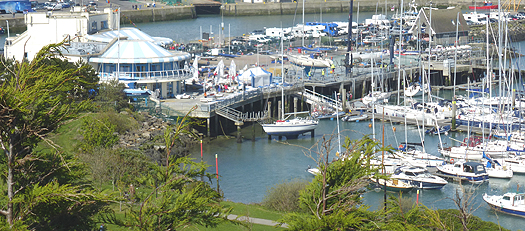
Multiple activities under way at Howth YC this week. The club's setup may seem only natural now, but it was quite a struggle to get there. Photo: W M Nixon
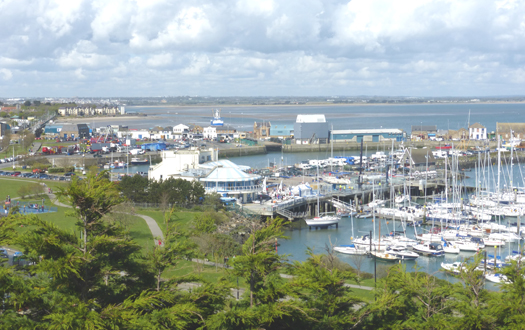
Howth's vibrant mix of a working fishing port and busy sailing centre has provided the ideal setting for the development of a successful visitor and seafood destination. Photo: W M Nixon
It's all history now, but it was done. And done so well by those involved that today it's simply taken for granted. Arguably, it's a compliment to those who created the Howth YC setup, that newer members should seldom wonder how it all came to happen, it just seems so right and natural. And as for those running the club, they in turn have to build on past achievements in dealing with an ever-changing administrative environment in which the changeover to being part of Fingal was only one of several evolutions.
Yet the recent attempt to abolish Fingal was a wake-up call. In Howth we may have wandered into it, but in just a dozen years, a dormant Fingal identity has come quietly but strongly awake. In Howth village it's natural enough, as our backs are turned to Dublin and we look to the rest of Fingal. But even on the south side of the hill, where fine houses face across Dublin Bay and you'd expect a sense of identity with households in similarly choice locations for all that they look north out of Dun Laoghaire, you find that the attraction of visiting the southside has the exotic appeal of going foreign, while those of us more humbly placed in the village, if visiting remote places like Rathmines or Terenure, find it positively unnerving to think of all the houses between us and the sea.
Then too, while Fingal Council has been establishing itself in our hearts and minds, it has been a good time for Howth Harbour. Good fences have been making good neighbours, and though marine administration in government has been kicked from pillar to post, an underlying Department of Fisheries recognition that their harbours cannot be only about fishing has led to a re-think on the use of buildings about the harbour, with Howth becoming an extraordinary nexus of good seafood restaurants, such that on a summer evening, despite the presence of a traditional fish and chip shop, the seafood aroma is of a proper fishing port in Brittany or Galicia. In fact, rents from the hospitality and sailing and marine industries in Howth have now reached such a level that fish landing fees – formerly the bedrock of the harbour economy – only contribute about 10% of the overall income.

The man from County Hall. Fingal Mayor Kieran Dennison is comfortable with his county's busy sailing activities, and the sailors are comfortable with him. He is seen here officially opening the J/24 Worlds at Howth in August 2013. Photo: W M Nixon
As for how we've been getting on with our new masters in County Hall up in Swords, the news is good. Most recently, we've been having direct contact with the current Mayor of Fingal, Kieran Dennison, who hit just the right note when he officially opened the J/24 Worlds in Howth in August 2013. Following that, he was back at the annual Commodore's Lunch in HYC in the dark days of November when a review of the past season lightens the onset of winter, and he was able to tell us that thanks to contacts made at the Worlds, his invitation to visit the America's Cup in San Francisco in September was made even more enjoyable. Those of us who reckoned the only way to visit the 34th America's Cup was on the television screen were reassured by the thought that if somebody was going to represent us in the San Francisco bear-pit, then our Mayor, our very own Mayor of Fingal, was just the man for the job.
So we very much want to keep Fingal in existence and in robust good health, but we appreciate that its current boundaries might be creating a bit of a Ukraine-versus-Russia situation. In particular, the southwest of the county could well be Fingal's Crimea and Donetsk regions. There, relatively new settlements of ethnic Dubs in places like Clonsilla, Castleknock, Blanchardstown could become such a source of trouble that it might be better to transfer them peacefully to administration by either Dublin city or South Dublin before there is unnecessary bloodshed.
The situation arises because, when the boundaries were being drawn, southwest Fingal was set out all the way down to the Liffey. The Fingallion instinct would be to see the border drawn along the Tolka, in other words the M3. But there could be trouble because of the discovery – always something of a surprise – that the Phoenix Park is in Fingal. I could see that when some people find our Fingal includes the Park, they'll want to fight for it, particularly as, in the southeast of the county, the excellent St Anne's Park in Raheny was somehow allowed to slip into Dublin City.
One thing which is definitely not for transfer is the Airport. It is naturally, utterly and totally part of Fingal. For sure, it contributes a fifth of the county's annual income from business rates, making Fingal the economically healthiest Irish county. But we in Fingal have to live with the airport very much in our midst. If Dublin really wants to take over the airport, then a first condition before negotiations even begin would be that all flight paths are to be re-routed directly over Dun Laoghaire and Dalkey. A few weeks of that would soon soften their cough.
Whatever, the recent kerfuffle about Fingal rejecting involvement in administration by an all-powerful Mayor of Dublin has been a powerful stimulant to thinking about how our own county might best be run. Everyone will have their own pet local projects, and most of us will reckon that decision-making in Swords, rather than in some vast and impenetrable office in the middle of Dublin, will be the best way to bring it about. For those of us who go afloat, the fact that Fingal Council shows that it cherishes its long and varied sea coast, rather than preferring to ignore it, is very encouraging. And the fact that this prospering county has some financial muscle all of its own gives us hope that we can build on what the past has taught us, and spread improved facilities to every port. Should that happen, it will in turn benefit Irish sailing and boating generally to a greater extent than would restricted development under one closely-controlled central administration headed by some southside megalomaniac.
Cork Harbour's Guilfoyle Leads Lasers at Youth Nationals
#youthsailing – Fresh from his significant 15th overall a week ago at the Laser Europa Cup in Marseille, Royal Cork's Seafra Guilfoyle took a three point lead after the initial three races in today's opening rounds of the youth national championships off Howth. Guilfyole has a 3, 1, 1 putting him in pole position ahead of Kinsale's Ross O'Sullivan and Royal Cork club mate Cian Byrne, who were also competing in France.
420 dinghy locals Robert Dickson and Sean Waddilove won the first two races and finished second in the final race of the day in the double–handed class. They lead Royal Cork's Harry Whitaker & Grattan Roberts and Peter McCann & Arran Walsh.
Full results here.
#hyc – Up to 250 of Ireland's top young sailors sail from the Fingal port of Howth in County Dublin this morning for the annual four-day Youth National Championships. Three separate race areas will be laid north of Ireland's Eye in order to accommodate the large number of competitors.
From the 24th to the 27th of April, Howth Yacht Club is hosting the annual youth sailing event on the domestic calendar.
In the Laser Radial class, many of last year's top performing sailors have progressed on to the senior Standard class. This has opened up the competition to the new wave of younger ambitious athletes eager to take the prized podium places. In the two-person 420 class, locals Robert Dickson and Sean Waddilove will be the ones to watch. The 2013 champions are currently in transition year and have spent their academic year studying in France where they have also been able to put in a lot of training and competition time on the water.
On a separate race course for the week, the 60 strong Optimist fleet will contest the first leg of their annual trials for representing Ireland abroad at a host of summer events. One of the pinnacle events will be the Optimist European Championship which this year will be hosted in Ireland by the Royal St George Yacht Club in Dun Laoghaire. With just under three months to go to the opening ceremony there are currently 250 registered sailors in the Dun Laoghaire event from 43 countries from as far afield as Bermuda, Japan, India and Iceland. They will arrive with 80 coaches and support personnel and many travelling with their families.
The ISA championships will also be complemented by Howth's annual Dublin Bay Prawn Festival, which will see the entire harbour front filled with tents and stalls offering various culinary delights related to the world-famous crustaceans. There will also be a carnival on the green of the harbour for the children and their families.
Howth Yacht Club & Royal St. George Team Racers To Represent Ireland At Wilson Trophy
#teamracing – This year Irish team racing hopes of success at the Wilson trophy rest on the shoulders of Howth Yacht Club and the Royal St. George YcC The highlight of the team racing calendar is next month when the top team racing nations make the journey to West Kirby to compete for the coveted trophy from 9 - 11 May.
HYC will be represented by Simon Rattigan, Geoff Tait and Darragh O'Connor as helms and Lynn Reilly, Lisa Tait and Emma Geary as respective crews. The team have been training hard this year and have shown good results in recent events - finishing in 2nd place in the Irish Team Racing Nationals and 1st place in the Trinity Invitational Trophy. A strong performace at The Wilson will certainly round off good season for HYC.
There will also be a Royal St George team competing at the Wilson Trophy, to be captained by Marty O'Leary - maintaining the tradition that dates back to the first ever edition of this event.
The Wilson Trophy, hosted by the infamous West Kirby Sailing Club, is the most prestigious team racing event in the world attracting 32 of the most competitive International teams. It is the most sought after prize within the world of team racing, in which HYC aims to continue to build a strong presence.
The team is targeting a quarter-final placing having narrowly missed out on this in the last number of editions
#quarterton – Hot on the heels of its Sportsboat Cup announcement for June, busy Howth Yacht Club in North Dublin has today announced that its Class 2 and 3 East Coast Championships scheduled for August will incorporate the Irish Quarter Ton Cup. Running over the 16th and 17th August, the two day event is sponsored by Euro Car Parks.
The Quarter tonners are looking forward to a busy season with participation at Dublin's ICRA Nationals in June from June 13–15 in Dun Laoghaire before heading across the bay to Howth for the Sportsboat Cup from June 20 to 22 and then the Quarter Ton Championships itself in August.
A class event poster and the notice of race is available to download below.
Great Food, Great Fun At Howth's Dublin Bay Prawn Festival
#MaritimeFestivals - It's April, which means it's almost time for the annual Dublin Bay Prawn Festival - running this year from Friday 25 to Sunday 27 April.
Whatever way you like your prawns – barbecued, whole, shelled, fried, skewered, marinated or sauced – Howth’s many award-winning restaurants will serve your favourite prawn dishes in bite-sized portions at the Food Village adjacent to Howth Yacht Club.
But the food is just one part of a whole programme of events over the weekend that includes a mystery dine-around, historic walking tours of the North Dublin fishing village, and a 'Prawn Push' in aid of Howth RNLI.
And just like last year, Dublin Bay Cruises will be running special trips to Howth, this time from the city centre - so you can arrive at the festival by sea!
Full details of this year's Dublin Bay Prawn Festival are available on the official website HERE.
Is Optimist Competition Pushing Kids Too Hard?
#opti – As Ireland prepares to welcome a record fleet of youngsters to the Optimist dinghy European Championships in Dun Laoghaire in four months time, Afloat.ie reader David Quinn questions the level of intensity of this winter's training and asks is this developing a life long love for sailing, or creating the environment where a tiny minority can push for Olympic Glory, while the rest take up another sport?
I live close to the Harbour in Howth, County Dublin so I tend to walk the pier or drive past the Yacht Club most weekends. This winter, much more than previous years, I have become really bothered and concerned at the extent of winter junior training sessions, particularly with the Optimist Class.
I started sailing relatively late so don't have much knowledge or experience of the Optimist Class. I started out in Mirrors before moving to Standard Rig Lasers. We trained hard, as an informal group, in Howth and competed internationally, but this was only in our late teens and early twenties. It is noticeable how many of my peers from that time are still sailing now and have a great love for the sport. I put that down to the huge fun we had racing Mirrors in Sutton Dinghy Club and at Regional events.
The major issues facing our sport are the fall off in memberships, declining activity and the lack of youth members in our clubs. I think a close scrutiny of the Optimist class would go some way to explaining some of the underlying problems in our sport!
I don't have an exact count, but the Optimists must have done at least four intensive training weekends, each with six hours of training per day. I'm not involved in the class so I can't be certain of the timing or intensity, but they seemed to launch before 10am and finish at dusk most days. I'm sure they came in for lunch. Is this developing a life long love for sailing, or creating the environment where a tiny minority can push for Olympic Glory, while the rest take up another sport?
I know some in the ISA are very concerned with this level of intensity for such young sailors, but the class, driven by over-ambitious parents, takes no notice. I doubt this is developing a life-long love for the sport, and I doubt it is even encouraging the kids to become elite sailors.
Maybe 1/100 will make it to senior international funded sailing? I would love to see a wider debate on the subject? I know when I was in my teens I sailed Mirrors and had a ball. It wasn't exactly an elite pathway class, but most of my peers from those days still race and sail very actively 25 years later. There must be a lesson there and it would make for an interesting study?
David Quinn (40) is a Laser and SB20 Sportsboat sailor from Howth Yacht Club and a former racing manager of the ISA.
Healthy Turnout For Howth YC's Round Island Race
#HYC - Howth Yacht Club has a round-up of all the action from the Round Island Race on Saturday 15 March, with the wind's turbulence making for a tough day's sailing around Ireland's Eye.
But in spite of the poor weather forecast, a healthy total of 31 boats took part in the St Patrick's weekend event, including many Laser Radials and 4.7s - and all were challenged by conditions that varied from 17-knot breeze to strong gusts.
The HYC website has all the details and results HERE.
Cull Beats Craig for Laser Howth Honours
#hyc – Sailors were greeted with a stiff 12 to 15 knot Southerly, as the sun slowly but surely managed to break through the clouds in what proved an eventful last day of Howth Yacht Club's laser series on Sunday.
Two races were sailed back to back, with the tide dictating the tactics on the start line and subsequent beats. Despite the busy Committe boat end the fleet had a clean start as most of the sailors tacked early out to the right. For those who fancied their luck on the left side of the course could only watch as the Starboard tackers crossed in front by a country mile. Conor Murphy of Malahide, fresh from his win at the IUSA Intervarsities,led this race from start to finish in what was a deserving win, despite the efforts of Paul McMahon who was in hot pursuit!
The strong flood tide reassured sailors that there was only one way to sail the beat, and that was to head for the Starboard layline. Again, the fleet got away cleanly and most tacked immediately out to the right. Ronan Cull led from Sean Craig at the WW mark and the two managed to hold their positions to the end.
The overall standings for the Standard Rig: 1st Place - Ronan Cull; 2nd Place - Sean Craig; 3rd Place - Colm Cunningham
In the Radial, Aoife Hopkins took first prize to round off a successful Winter season.
Next week will officially conclude proceedings with the Annual Round the Island race, and here at Howth we're hoping for a great turnout once again from near and far.
This year will also see the RS 400 fleet join in on the fun, so hopefully the weather holds out!"
#hyc– A more civilised wind forecast greeted the Howth Frostbite sailors last Sunday, with a Fresh SSE at 15knots made for an enjoyable two races in the rain. The Race Committee (RC) ran two great Olympic course races for the 16 sailors who made it to the start line.
Race 1 saw an early start with most of the fleet over the line due to the turning ebb tide.
After a General Recall, the fleet got away successfully with a Committee boat favoured start line. Those who started near the RC boat were able to climb over those further down the line in a lifting gust out to the Port lay line. Racing was tight up the first beat on this occasion with the top five boats rounding within seconds of each other at the top mark.
A tricky cross swell on the run made for a few capsizes and those who stayed in the gusts on the left side of the downwind run made significant gains. Paul McMahon took line honours after fending off several chasing sailors.
Race two got underway with a Port favoured line with the leaders coming off the pin sailing to the left side of the course. Paul McMahon, once again took the initiative by putting some good distance between himself and the chasing pack on the reaches.
The Final race day of the series is next Sunday so we're hoping for a big turnout!



























